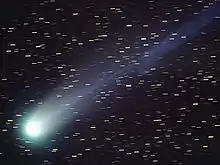 | |
| Discovery | |
|---|---|
| Discovered by | Nobuhisa Kojima at Ishiki, Aichi, Japan |
| Discovery date | 27 December 1970 |
| Orbital characteristics | |
| Epoch | 2014-Dec-9 |
| Aphelion | 5,345 AU |
| Perihelion | 2.0068 AU |
| Semi-major axis | 3.6759 AU |
| Eccentricity | 0.4541 |
| Orbital period | 7.05 yr |
| Inclination | 6.6003° |
| Last perihelion | 2021-Nov-03[1] 2014-Oct-20 |
| Next perihelion | 2028-Nov-21[2] |
70P/Kojima is a periodic comet in the Solar System with a current orbital period of 7.05 years.[3][4]
It was discovered at Ishiki, Aichi, Japan by Nobuhisa Kojima, who estimated its brightness at magnitude 14. Its parabolic orbit was calculated by Kiichirō Furukawa to have a perihelion date of 1 November 1970. This was revised on the basis of further observations to an elliptical orbit with a perihelion of 7 October and an orbital period of 6.16.
Hiroki Kosai and Furukawa relocated the comet on 9 December 1977 at its next predicted apparition with the 105 cm Schmidt telescope at the Kiso Station of the Tokyo Astronomical Observatory, estimating its brightness at magnitude 16. It was subsequently observed in 1985/1986 and 1992/1994 by Spacewatch with magnitudes of 20 and 22.1. The comet then passed close to Jupiter, which reduced the perihelion distance from 2.4 AU (Astronomical Unit) to 1.97 AU, increased the eccentricity from 0.39 to 0.46 and reduced the orbital period from 7.85 to 6.99 years.
See also
References
- ↑ MPC
- ↑ "Horizons Batch for 70P/Kojima (90000714) on 2028-Nov-21" (Perihelion occurs when rdot flips from negative to positive). JPL Horizons. Retrieved 2023-07-06. (JPL#60 Soln.date: 2023-Apr-05)
- ↑ "70P/Kojima". Retrieved 22 February 2015.
- ↑ "Elements and Ephemeris for 70P/Kojima". International Astronomical Union. Archived from the original on 4 March 2016. Retrieved 22 February 2015.

.png.webp)